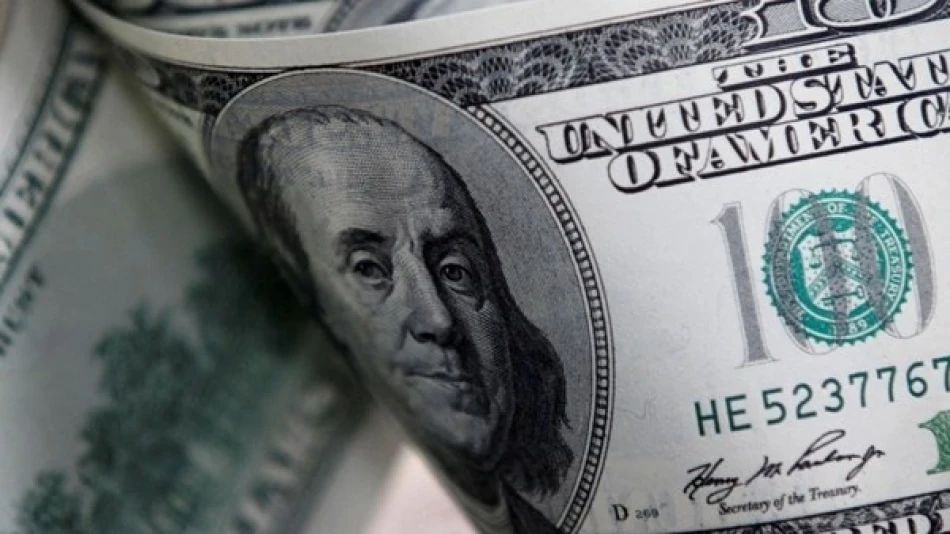
Slumping Dollar as Rate Cut Speculation Grows
Dollar Weakens as Fed Rate Cut Expectations Mount Amid Tariff Uncertainty
The US dollar declined Tuesday as growing expectations of Federal Reserve interest rate cuts weighed on investor sentiment, while markets continue to assess the broader economic impact of American tariffs that took effect last week. The currency remains under pressure following Friday's weak jobs report, which has traders increasingly betting on monetary easing next month.
Labor Market Weakness Drives Fed Policy Expectations
Friday's disappointing employment data has fundamentally shifted market expectations around Federal Reserve policy. The weak jobs report signals potential cracks in the US labor market's resilience, providing the Fed with justification for more accommodative monetary policy. This marks a significant shift from the hawkish stance that dominated much of 2023, when inflation concerns kept rate cut expectations at bay.
The dollar index, which measures the greenback against six major currencies, fell to 98.688 after touching a one-week low earlier in the session. Despite a brief recovery Monday, the currency has resumed its downward trajectory as traders price in higher odds of rate cuts.
Currency Market Movements Reflect Shifting Dynamics
Major currency pairs are reflecting this dollar weakness across the board. The euro gained ground to $1.1579, while the British pound held steady at $1.3298. These levels suggest renewed confidence in European currencies as the dollar's yield advantage begins to erode.
Japan Signals Policy Flexibility
The Japanese yen strengthened slightly to 146.95 against the dollar following revelations from the Bank of Japan's June meeting minutes. Several central bank members indicated they would consider resuming interest rate increases if trade tensions ease—a notable shift that suggests Japan is preparing for policy normalization contingent on global stability.
This conditional approach reflects Japan's delicate balancing act between supporting economic growth and managing currency stability, particularly as the yen has faced significant pressure over the past year.
Trade War 2.0: Switzerland in the Crosshairs
The Swiss franc stabilized at 0.8081 per dollar after falling 0.5% in the previous session, as Bern prepares to offer a "more attractive proposal" in trade negotiations with Washington. Switzerland faces the threat of 39% tariffs on its exports to the US—a move that could devastate its export-dependent economy.
This development highlights how the new wave of US protectionism extends far beyond traditional trade rivals like China, potentially reshaping relationships with longtime allies. Switzerland's situation mirrors challenges faced by other export-oriented economies that must now navigate an increasingly fragmented global trade environment.
Market Implications and Investor Strategy
The combination of dovish Fed expectations and trade uncertainty creates a complex environment for currency traders. While dollar weakness typically benefits emerging markets and commodity currencies, the unpredictable nature of tariff implementation adds significant volatility risk.
Australian and New Zealand dollars both gained 0.11%, reaching $0.64736 and $0.5914 respectively, as investors sought exposure to commodity-linked currencies that typically benefit from dollar weakness. However, these gains remain modest, reflecting cautious optimism rather than conviction.
Looking Ahead: Structural Dollar Decline or Temporary Pullback?
Market analysts increasingly view the dollar's strength as unsustainable in the current environment. The convergence of potential Fed easing, trade policy uncertainty, and global economic rebalancing suggests a structural shift rather than a temporary correction.
The long-term impact of tariffs remains unclear, but their immediate effect is to introduce significant uncertainty into currency markets. This uncertainty, combined with changing monetary policy expectations, creates conditions for continued dollar volatility and potential weakness.
For investors, this environment demands careful risk management and diversification strategies. The era of straightforward dollar strength may be ending, replaced by a more complex landscape where trade policy and monetary policy interact in unpredictable ways.
 Layla Al Mansoori
Layla Al Mansoori







